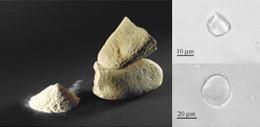Les Européens - vivant il y a 30000 ans - fabriquaient dejà de la farine.
Source : http://www.maxisciences.com/pr%e9histoire/prehistoire-les-europeens-vivant-il-y-a-30-000-ans-fabriquaient-deja-de-la-farine_art9856.html
Europe – Relatée lundi 18 octobre dans la revue américaine Proceedings of the National Academy of Sciences (PNAS), la découverte de résidus d’amidon sur des meules en pierre par une équipe italienne fait remonter 10.000 plus tôt la consommation de farine végétale chez nos ancêtres du Paléolithique.
La découverte de grains d’amidon, sur des meules primitives en pierre trouvées sur des sites paléolithiques de Russie, d’Italie et de République Tchèque, a permis à l’équipe du Dr Anna Revedin, de l’Institut de préhistoire de Florence (Italie), de faire remonter la fabrication de farine à 30.000 ans. Jusqu’alors, les plus anciennes traces de cette activité, trouvées en Israël, dataient de 20.000 ans.
Issue de plantes riches en amidon comme la fougère ou la quenouille, la farine était vraisemblablement mélangée à de l’eau pour produire une pâte, cuite sur une pierre chaude. Les archéologues se sont essayés à la recette, obtenant une sorte de pain plat, "croustillant comme un biscuit mais pas très savoureux".
Ramasser les plantes nécessaires et les traiter avec des outils adéquats pour en tirer un aliment digeste et riche en glucides sont des opérations complexes, qui témoignent d’une diversité alimentaire assez importante chez nos ancêtres, chassant l’image de l’homme préhistorique presque exclusivement carnivore.
Stone Age flour found across Europe
Starch residues on stone tools suggest early humans ate a balanced diet.
Ewen Callaway
Source : http://www.nature.com/news/2010/101018/full/news.2010.549.html
Once thought of as near total carnivores, early humans ate ground flour 20,000 years before the dawn of agriculture. Flour residues recovered from 30,000-year-old grinding stones found in Italy, Russia and the Czech Republic point to widespread processing and consumption of plant grain, according to a paper published online this week in Proceedings of the National Academy of Sciences1.
"It's another nail in the coffin of the idea that hunter–gatherers didn't use plants for food," says Ofer Bar-Yosef, an archaeologist at Harvard University in Cambridge, Massachusetts, who was not involved in the study. Work in recent years has also uncovered a handful of Stone Age sites in the Near East with evidence for plant-eating.
The meat-centric view of early modern humans stems partly from the fact that meat-eating leaves a more indelible mark in the archaeological record than omnivory, says Laura Longo, an archaeologist at the University of Siena in Italy and an author on the paper.
Stone blades used for hunting and animal bones bearing cut-marks are common finds, whereas plants leave few relics. Complicating matters, archaeologists typically washed the grinding tools used to process plants, removing any preserved plant matter, says Longo.
Early omnivores
Beginning in the early 2000s, Longo and her colleagues started analysing unwashed stone tools from a 28,000-year-old human settlement in central Italy called Bilancino. Patterns of wear on the sandstone tools suggest that they were used for grinding, like a mortar and pestle. The stones were also coated with several kinds of microscopic starch grains. Longo and her colleagues identified the grains based on their shape as belonging to the root of a species of cattail and the grains of a grass called Brachypodium.
The researchers also found grinding tools coated with cattail and fern residues at human sites in southern Moravia in the Czech Republic and south of Moscow, all dated to roughly 30,000 years old.
Unlike Neolithic humans, who domesticated and cultivated grains such as wheat and barley, these hunter–gatherers relied on wild vegetation. However, many of the plants found by Longo and her team were widely distributed, offering a reliable, even nutritious source of food, she says. For example, once ground and cooked, the cattail grains contain nearly as much energy as domesticated cereals, the researchers calculate.

Grinding tools bear traces of 30,000-year-old cattail and fern (right).PNAS
Bar-Yosef says that the study proves that flour-making was common to early modern humans. "I'm pretty sure that you're going to have many more cases where there is evidence for the use of plants by humans."
Bruce Hardy, a paleoanthropologist at Kenyon College in Gambier, Ohio, expects that flour-making dates back even further than 30,000 years. "This is not isolated to a small group of people. It's a regular part of subsistence for humans," he says.
After all, humans, ancient or modern, just aren't equipped to live on a diet of meat alone. "If you get that much meat in your diet not balanced out with other nutrients, you get protein poisoning," says Hardy.